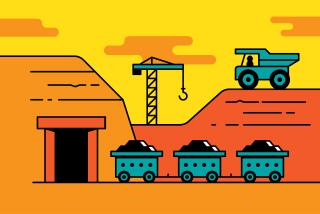Utah uranium mine is more of a bad memory than a historic site for many
Tom Zoellner was camping a few years back in the rocky and isolated wilds of southeastern Utah when he came across some strange holes in the earth.
“They were weird excavations on the mesa not caused by erosion or weather,” said Zoellner, an author and former journalist. “So I poked around and saw they were propped up by beams. And I said, ‘My gosh. These are mines.’”
Not just any mines. Locals around Moab told Zoellner these were the remnants of former uranium mines that were most active at the height of the Cold War, which prompted a wave of prospecting frenzy for the silvery-white metal that launched what many call Utah’s version of the California Gold Rush.
Zoellner wanted to erect a placard to explain the mine’s historic significance. But the idea has not gained the wholehearted support he expected. Many here consider the mine a stain on the area’s history. Others don’t relish the idea of celebrating the mine’s former owner, a rakish former oil geologist named Charles A. Steen.
Nobody’s picketing (yet), but neither have residents vocally supported the idea. The subtle resistance to the uranium mine once called Mi Vida — “my life” — baffles Zoellner.
Founded in 1952, the mine is considered the first big strike in the burgeoning market for uranium, mostly to fuel the growing U.S. standoff with the Soviet Union.
“I had spent two years in Utah and wasn’t aware of this transformative chapter in the state’s history,” said Zoellner, 46, who now teaches English at Chapman University in Orange County. “Fuel for the Cold War was taken from this astonishing landscape.”
In 2011, Zoellner published a book titled “Uranium: War, Energy and the Rock that Shaped the World,” the biography of a controversial element that, as Zoellner writes, can either sustain earth or destroy it.
He became transfixed by Steen, a flamboyant Texan who threw annual parties in a local airport hangar — a millionaire miner who had his original prospecting boots preserved in bronze, who flew to Salt Lake City in his private plane for rumba lessons.
Years after his death in 2006, Steen remains controversial in this conservative region. “He was a champagne-drinking Texan,” Zoellner said. “Not the greatest cultural fit in Mormon ranching country.”
Still, Zoellner wants to erect a bronze historical marker along U.S. Highway 191 near Moab to let tourists and passersby know about the history that occurred just seven miles distant. He envisions “a marker with four simple sentences about what happened just over the rise.”
In a region popular with off-road enthusiasts, many mountain bikers and ATV riders have no clue that the trails they use were carved into the wilderness as roads that served Mi Vida and other uranium mines.
Utah state laws require an application with the highway department, as well as a sponsoring institution, for a historical marker. Zoellner went to the historical society in nearby San Juan County.
They weren’t too keen on the idea. Said Zoellner: “They said they never thought much of Steen.”
So Zoellner appealed to the Museum of Moab, which agreed to act as sponsor. In a fundraising plea for the monument, museum officials recall the uranium mines’ impact on the region, the bad as well as good: “The discovery received lavish international press coverage and inspired even more to join the hunt. The mining was occasionally reckless and without meaningful safety protocols. At least six hundred miners suffered disease and early death because of the radioactivity.”
Museum director John Foster said that the image of pulling uranium from the ground — and its inherent danger — still rubs raw with some residents.
“Certainly, there are people on both extremes,” he said. “People remember not only the health effects but the strain the mine put on the area’s infrastructure. With so many people moving here, there was no place for many to sleep. The city couldn’t keep up with its sewer and water services.”
For many residents, “the whole mine was a curse, while others remember that only good came from it,” Foster said. “The truth is somewhere in the middle — and it’s a whole lot more complex.”
Zoellner says that good or bad, the mine still represents a colorful chapter in U.S. history. “Think of the number of sites in U.S. history that commemorate tragic and ambiguous occurrences,” he said. “Look at the Alamo. The argument is never going to end as to who was right and who was wrong.”
So far, the museum has raised only $2,000 of the $5,000 cost for road grading, and Zoellner is optimistic the state will approve the proposal. He has yet to write the words for the marker and knows it must consider competing narratives.
“Words alone are not going to make every party happy,” he said.
And if trekkers decide to tour the mine area, they might feel a bit of the character that Charles Steen brought to the place: His ashes and those of his wife, Minnie Lee, are scattered around the site.
More to Read
Sign up for Essential California
The most important California stories and recommendations in your inbox every morning.
You may occasionally receive promotional content from the Los Angeles Times.











